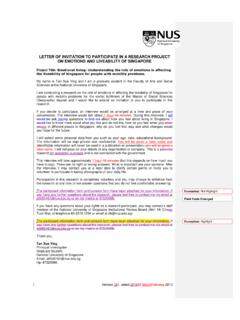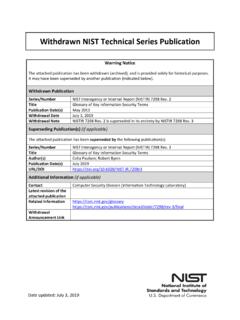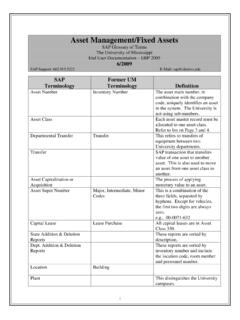Transcription of GLOSSARY OF DISABILITY TERMINOLOGY - DPA
1 2 Copyright 2015 Disabled People s Association, Singapore GLOSSARY of DISABILITY TERMINOLOGY is published by the Disabled People s Association, Singapore (DPA) 1 Jurong West Central 2 #04-01 Jurong Point Shopping Centre Singapore 648886 All rights reserved. No part of this publication may be reproduced, stored in a retrieval system or transmitted, in any form or by any means, electronic, mechanical, photocopying, recording or otherwise, without the prior written permission of the publisher. 3 A Able-bodied: Sometimes used incorrectly as an antonym of disabled in phrases such as Disabled people, unlike able-bodied The preferred antonym for disabled is non-disabled or person without a DISABILITY . Access: Suitability of a building or other structure for use by people with disabilities. In a broader sense, access also included making forms and information accessible to people with visual or cognitive disabilities; making alarms and signals accessible to people who are deaf or hard of hearing; and making services such as education and transport accessible to people with disabilities.
2 Access aisle: An accessible pedestrian space, for example, between parking spaces, seating or desks that provides appropriate clearance for use of those parking spaces etc. Access audit: Detailed examination of a building or other structure, generally by independent experts, to ascertain its suitability for use by people with disabilities. Accessibility: The degree to which a building or other structure provides access for (mainly physically) disabled people. In Singapore, this is determined primarily by the Building and Construction Authority s Code on Accessibility in the Built Environment. Accessible: In the case of a facility, readily usable by a person with disabilities (PWD); in the case of a program or activity, presented or provided in such a 4 way that a PWD can participate, with or without auxiliary aid(s); in the case of electronic resources, accessible with or without assistive computer technology.
3 Accessible route: A continuous unobstructed path connecting all accessible parts of a building or facility. Interior accessible routes may include corridors, floors, ramps, elevators, lifts, and clear floor space at fixtures. Exterior accessible routes may include parking access aisles, curb ramps, crosswalks at vehicular ways, walks, ramps and lifts. Accessible tourism: A form of travel or tour operation specially catered to the needs of people with disabilities: Braille signs and audio tours for the blind/visually impaired are common examples, as are closed captions on information videos, wheelchair ramps, and ready access to elevators. Accessible web design: Creating web pages according to universal design principles to eliminate or reduce barriers, including those that affect people with disabilities.
4 Ideally, all websites should conform to Level AAA of the Web Content Accessibility Guidelines For more information about these guidelines, please see the W3C Web Accessibility Initiative website at Acid maltase deficiency: Also called AMD, Pompe disease, glycogenosis type 2, acid-alpha glucosidase deficiency, lysosomal storage disease. A metabolic muscle disorder, a group of diseases that interferes with the processing of food (in this case, carbohydrates) for energy production. This disease causes slowly progressive weakness, especially of the respiratory muscles and those of the hips, upper legs, shoulders and upper arms. For more information, see the websites of: Muscular Dystrophy Association (Singapore) Muscular Dystrophy Association (USA) - 5 Activity: The execution of a task or action by an individual.
5 (World Health Organisation: International Classification of Functioning, DISABILITY and Health (ICF) - Definitions in the context of health, Exposure Draft, Oct 2013.) Activity limitations: Difficulties an individual may have in executing activities. (World Health Organisation: International Classification of Functioning, DISABILITY and Health (ICF) - Definitions in the context of health, Exposure Draft, Oct 2013.) Activities of daily living: In the context of rehabilitation and independent living by people with disabilities, these include dressing, making the bed, showering, shaving, combing hair, eating, making drinks and all other activities which will assist in enabling a person with a DISABILITY to function to the maximum of his or her capacity within the family and the community. Adaptability: The ability of certain building spaces and elements, such as kitchen counters, sinks and grab bars, to be added or altered so as to accommodate the needs of persons with different types or degrees of DISABILITY .
6 Adaptive technology: Any object or system that is specifically designed for the purpose of increasing or maintaining the capabilities of people with disabilities - often refers specifically to electronic and information technology access. ADHD / Attention Deficit Hyperactivity: This term now includes ADD / Attention Deficit Disorder - a disorder that appears in early childhood. ADHD makes it difficult for people to inhibit their spontaneous responses (responses can involve everything from movement to speech to attentiveness). People with ADHD may be: Inattentive, hyperactive, and impulsive (the most common form) Inattentive, but not hyperactive or impulsive. Hyperactive and impulsive, but able to pay attention 6 For more information, see the websites of SPARK (Society for the Promotion of ADHD Research and Knowledge) - Association for Persons with Special Needs - Adult-onset macular vitelliform dystrophy: A slightly different eye condition to Best disease.
7 In adult-onset macular vitelliform the changes begin much later in life (around the age of 40 to 60) and they do not progress in the same way. The change to vision can be so small that often it is detected by chance through a routine eye test: There is less impact on vision than Best disease. For more information, see the Genetics Home Reference website, a service of the US National Library of Medicine at Advocacy: A process of supporting and enabling people to express their views, to access information and services, to find out about options and make decisions, and to secure their rights. Advocate: In the DISABILITY context, this is someone, who may or may not themselves have disabilities, who speaks or intercedes for people with disabilities. ALS, also known as amyotrophic lateral sclerosis, motor neurone disease or Lou Gehrig s Disease: A disease of the parts of the nervous system that control voluntary muscle movement.
8 Nerve cells that control muscle cells are gradually lost, causing the muscles to become weak and eventually non-functional. Walking, talking, eating, hugging and even breathing become nearly impossible, although the mind stays sharp. For more information, see the websites of Muscular Dystrophy Association (Singapore) - Muscular Dystrophy Association (USA) - 7 Alstr m Syndrome: A very rare recessively inherited genetic disorder which means that both parents will carry the gene although probably be unaffected themselves. Alstr m Syndrome is characterised principally by: Retinal Degeneration (inherited progressive eye disease) Sensorineural Hearing Loss (disorders of the cochlear part of the ear) Obesity and Insulin Resistance Nystagmus (wobbly eyes) For more information, see the websites of Singapore Association of the Visually Handicapped - Royal National Institute of Blind People (RNIB) website - ALT attribute: Provides an alternate text for a computer user, if (s)he cannot view the image (for example because of a slow connection or because (s)he uses a screen reader/ is visually impaired.)
9 Here is an image for which the alt attribute is "In the sky flies a red flag with a white cross whose vertical bar is shifted toward the flagpole." An alternative alt attribute value would be "The Danish flag". A visually impaired reader using a screen reader such as Orca will hear the alt text in place of the image. A text browser such as Lynx will display the alt text instead of the image. A graphical browser typically will display only the image, and will display the alt text only if the user asks it to show the image's properties or has configured the browser not to display images, or if the browser was unable to retrieve or to decode the image. 8 Alcohol-Related Neurodevelopmental Disorder (ARND): People with ARND (a Fetal alcohol spectrum disorder or FASD) might have intellectual disabilities and problems with behaviour and learning.
10 They might have difficulties with math, memory, attention, judgment, and poor impulse control. Alternative input devices: Allow individuals to control their computers through means other than a standard keyboard or pointing device. Examples include: Alternative keyboards featuring larger- or smaller-than-standard keys or keyboards, alternative key configurations, and keyboards for use with one hand. Electronic pointing devices used to control the cursor on the screen without use of hands. Devices used include ultrasound, infrared beams, eye movements, nerve signals, or brain waves. Joysticks manipulated by hand, feet, chin, etc. and used to control the cursor on screen. Sip-and-puff systems activated by inhaling or exhaling. Touch screens allow direct selection or activation of the computer by touching the screen, making it easier to select an option directly rather than through a mouse movement or keyboard.








